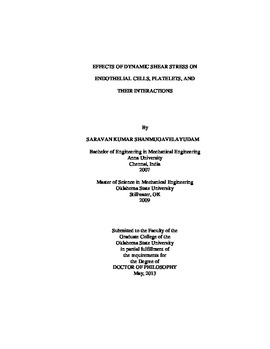| dc.contributor.advisor | Yin, Wei | |
| dc.contributor.author | Shanmugavelayudam, Saravan Kumar | |
| dc.date.accessioned | 2014-09-24T14:16:44Z | |
| dc.date.available | 2014-09-24T14:16:44Z | |
| dc.date.issued | 2013-05 | |
| dc.identifier.uri | https://hdl.handle.net/11244/10988 | |
| dc.description.abstract | Coronary heart disease (CHD), characterized by degenerative changes in coronary circulation, is the leading cause of death in the US. Vascular wall endothelial cells (EC) and circulating blood platelets play a major role in pathogenesis of CHD. The normal functions and activities of EC and platelets can be significantly affected by blood flow induced shear stress. The major goal of this study was to estimate shear stress environment in the human left coronary artery using a computational fluid dynamics model, and to examine the effect of physiologically relevant dynamic shear stress on endothelial cells, platelets and their interaction. In this study, numerical simulations were conducted using a physiologically realistic left coronary artery 3D model under normal and disease (stenosis) conditions. The results indicated highly disturbed flow patterns under stenosis conditions. The dynamic shear stress waveforms (physiological and pathological) from numerical studies were applied to EC and platelets using a cone and plate shearing device, or a parallel plate flow chamber. Pathological shear stress (low and high) could significantly affect EC activation. For platelets, pathological shear stress induced significant changes in platelet proteome profiles, and caused complement activation. However, when platelets and EC were exposed to the same dynamic shear stress simultaneously, both EC and platelet response to shear stress changed. Pathological shear stress failed to activate EC, or lead to platelet complement activation. Further, when EC and platelets were sheared simultaneously, platelet adhesion to EC monolayer was observed, especially under low pulsatile shear stress. Together, the results suggest that platelet-EC interaction could protect EC and platelets from dynamic pathological shear stress, and it is potentially through physical contact between platelets and EC, i.e., platelet adhesion to EC. Further investigation is needed to identify mediators in this protective mechanism, which may lead to new therapeutic solutions to atherosclerosis and coronary artery disease. | |
| dc.format | application/pdf | |
| dc.language | en_US | |
| dc.rights | Copyright is held by the author who has granted the Oklahoma State University Library the non-exclusive right to share this material in its institutional repository. Contact Digital Library Services at lib-dls@okstate.edu or 405-744-9161 for the permission policy on the use, reproduction or distribution of this material. | |
| dc.title | Effects of dynamic shear stress on endothelial cells, platelets and their interactions | |
| dc.contributor.committeeMember | Rubenstein, David A. | |
| dc.contributor.committeeMember | Fahlenkamp, Heather Dawn Nicole | |
| dc.contributor.committeeMember | Lloyd, Pamela G. | |
| osu.filename | Shanmugvelayudam_okstate_0664D_12617.pdf | |
| osu.accesstype | Open Access | |
| dc.type.genre | Dissertation | |
| dc.type.material | Text | |
| thesis.degree.discipline | Mechanical Engineering | |
| thesis.degree.grantor | Oklahoma State University | |
